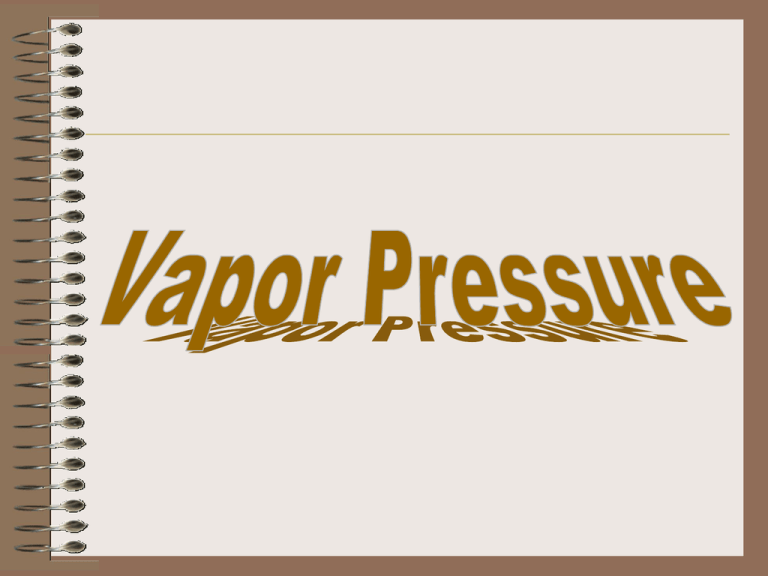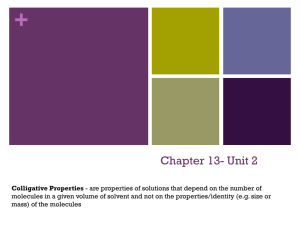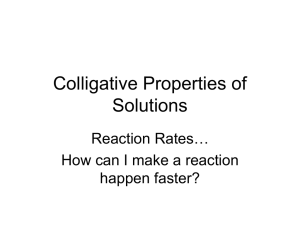Vapor Pressure
advertisement

VAPOR PRESSURE The term "vapor" is applied to the gas of any compound that would normally be found as a liquid at room temperature and pressure For example, water, gasoline, rubbing alcohol, and finger nail polish remover (ethyl acetate) are all normally liquids, but they all evaporate to give a gas. The molecules that are found on the upper side have only about half as many neighbors as do molecules inside the liquid so to begin with the forces holding them in the liquid are slightly lower than molecules in the bulk liquid. The rate at which a given volume of liquid will evaporate is determined by the surface area. In order for a molecule to break free of the liquid and go into the gas phase (evaporate) its kinetic energy must be greater than the forces holding it into the liquid. We recall that the distribution of kinetic energies in a collection of molecules is described by the Maxwell-Boltzmann relationship, so that at a given temperature only the fraction of molecules with kinetic energies greater than the intermolecular forces (as shown below) will be able to break free. NOTE: *the number of molecules with energies sufficient to break free will be proportional to the temperature. As the temperature increases a greater fraction of the molecules may break free. *At a given temperature, a liquid with low intermolecular forces will have a larger fraction of its molecules with sufficient kinetic energy to evaporate than a liquid with higher intermolecular forces. Another way of saying this is that the liquid with low intermolecular forces has a higher vapor pressure than a liquid with higher intermolecular forces. Equilibrium Vapor Pressure If we put the beaker in a closed chamber a slightly different phenomenon occurs. Now molecules from the liquid evaporate as before, but some of these evaporated molecules may also return to the liquid. Boltzman curve Boltzman curve in which we assume that only those molecules with energies in excess of some value (which we loosely relate to the Intermolecular Force) will be able to break free and go into the vapor phase. Obviously, surface area is important, but it doesn't affect the equilibrium vapor pressure, only the rate at which equilibrium is achieved. A simple Boltzman curve is illustrated below: Recall that we think of the area under the curve as representing all of the molecules in a container. If we had 1,000,000 molecules, then the area would represent these 1,000,000 molecules. Imagine we are going to make a solution in which we're going to dissolve some nonvolatile compound into our liquid. In real life we'd just put the compound into our liquid, but since we're trying to focus on the effect on the Boltzman curve, imagine we remove 1,000 solvent molecules and put in 1,000 solute molecules. This way we still have 1,000,000 molecules represented by the curve. Since the properties of the solvent and solute molecules should be additive, we can think of the Boltzman curve as being the sums of a Boltzman curve for the solvent and one for the solute. When a nonvolatile solute is added to a liquid to form a solution, the vapor pressure above the solution decreases The reasons . Liquid molecules at the surface of a liquid can escape to the gas phase when they have a sufficient amount of energy to break free of the liquid's intermolecular forces. That vaporization process is reversible. Gaseous molecules coming into contact with the surface of a liquid can be trapped by intermolecular forces in the liquid. Eventually the rate of escape will equal the rate of capture to establish a constant, equilibrium vapor pressure above the pure liquid. If we add a nonvolatile solute to that liquid, the amount of surface area available for the escaping solvent molecules is reduced because some of that area is occupied by solute particles. Therefore, the solvent molecules will have a lower probability to escape the solution than the pure solvent. That fact is reflected in the lower vapor pressure for a solution relative to the pure solvent. That statement is only true if the solvent is nonvolatile. If the solute has its own vapor pressure, then the vapor pressure of the solution may be greater than the vapor pressure of the solvent. On the surface of the pure solvent (shown on the left) there are more solvent molecules at the surface than in the righthand solution flask. Therefore, it is more likely that solvent molecules escape into the gas phase on the left than on the right. Therefore, the solution should have a lower vapor pressure than the pure solvent. The French chemist Francois Raoult discovered the law that mathematically describes the vapor pressure lowering phenomenon. Raoult's law states that the vapor pressure of a solution, P, equals the mole fraction of the solvent, csolvent, multiplied by the vapor pressure of the pure solvent, Po. P = csolvent * Po Raoult's law, is easy to understand. When the solvent is pure, and the mole fraction of the solvent is equal to 1, P is equal to Po. As the mole fraction of the solvent becomes smaller, the vapor pressure of the solvent escaping from the solution also becomes smaller. Let's assume, for the moment, that the solvent is the only component of the solution that is volatile enough to have a measurable vapor pressure. If this is true, the vapor pressure of the solution will be equal to the vapor pressure of the solvent escaping from the solution. Raoult's law suggests that the difference between the vapor pressure of the pure solvent and the solution increases as the mole fraction of the solvent decreases. Solutions that obey Raoult's law are called ideal solutions because they behave exactly as we would predict. Solutions that show a deviation from Raoult's law are called non-ideal solutions because they deviate from the expected behavior. When a solute is added to the solvent, some of the solute molecules occupy the space near the surface of the liquid. When a solute is dissolved in a solvent, the number of solvent molecules near the surface decreases, and the vapor pressure of the solvent decreases. This has no effect on the rate at which solvent molecules in the gas phase condense to form a liquid. But it decreases the rate at which the solvent molecules in the liquid can escape into the gas phase. As a result, the vapor pressure of the solvent escaping from a solution should be smaller than the vapor pressure of the pure solvent. The change in the vapor pressure that occurs when a solute is added to a solvent is therefore a colligative property. If it depends on the mole fraction of the solute, then it must depend on the ratio of the number of particles of solute to solvent in the solution but not the identity of the solute. Colligative Properties are those properties of a liquid that may be altered by the presence of a solute. Examples of Colligative Properties •vapor pressure •melting point •boiling point •osmotic pressure Colligative Properties • • • • Freezing point depression Boiling point elevation Osmotic pressure Vapor pressure lowering Colligative Properties Colligative properties of solutions depend only on the amount of solute! The type of solute plays no role other than being an electrolyte or non-electrolyte! Freezing Point Depression A solute will lower the freezing point of a solvent by lowering the vapor pressure of the solvent. The amount by which the vapor pressure is lowered can be calculated using Raoult’s Law. Freezing Point Depression The vapor pressure of a solution depends on the mole fraction of the solute, Xa, and the vapor pressure of the pure solvent. We assume that the vapor pressure of the solute is negligible. Freezing Point Depression To calculate the change in the freezing point of a solvent with a solute added, you need to know: – – – – The freezing point depression constant, Kf The molality of the solution The nature of the solute: electrolyte or nonelectrolyte The freezing point of the pure solvent Freezing Point Depression The change in freezing point, t, for any solute/solvent system can be calculated using this relationship: Δt = i · Kf · m Where I = dissociation factor Kf = freezing point depression constant m = molality of the solution Δt = change in freezing temperature Freezing Point Depression The molality of a solution is defined to be: m= moles solute kg solvent Freezing Point Depression The dissociation factor is one (1) for any nonelectrolyte. A non-electrolyte is a compound made of nonmetals and bonded by covalent bonds. Some examples of non-electrolytes are: 1. carbon dioxide 2. ethanol 3. sugars Freezing Point Depression The dissociation factor is for an electrolyte, which is a compound formed by a metal and nonmetal and bonded by ionic bonds, is determined by the number of ions that will be formed when dissolved in the solvent. For example, NaCl will form 2 ions in water and has an i value of 2. AlCl3 would form 4 ions in solution and has an i value of 4. Freezing Point Depression The change in freezing point, t, is calculated using this equation: Δt = TFinal - TInitial TFinal = the new freezing temperature of the solvent TInitial = the freezing point of the pure solvent Freezing Point Depression The freezing point depression constant is different for every solvent and must be provided (unless that is what is being asked in the question) For water, Kf = - 1.86C/m Freezing Point Depression Example: Calculate the freezing point of a solution made by adding 1.00 mole of sucrose to 1.00 kg water. Δt = i x Kf x m i = 1 for sucrose (covalent, nonelectrolyte) Kf = - 1.86C/m m = 1.00 m = 1.00 mole 1.00 kg Freezing Point Depression Δt = i x Kf x m Δt = (1) x (-1.86C/m) x (1.00 m) Δt = - 1.86C Freezing Point Depression Since Δt = - 1.86C, the actual freezing point of the solution can be calculated using: Δt = TFinal – TInitial and - 1.86C = TFinal – 0C (the freezing point of pure water) Freezing Point Depression The final answer is: - 1.86C = TFinal







